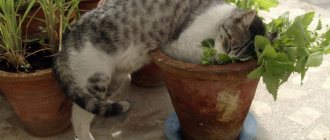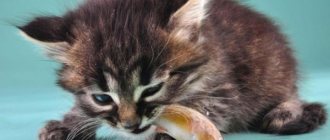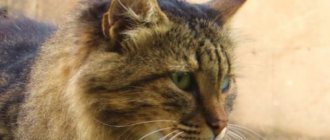6416Administration
1
Veterinarians often hear owners ask whether a cat can eat its kittens. Unfortunately, this phenomenon sometimes occurs and affects not only dead but also living cubs. This strange behavior occurs much less frequently in cats than in rabbits and pigs. However, a person who decides to start breeding cats needs to learn about their cannibalism in a timely manner in order to promptly take all the necessary measures to prevent this extremely unpleasant phenomenon.
The essence of the problem
In females, the instinct of motherhood is always highly developed. There are many cases where a mother cat sacrificed her life to protect her babies. And if a mother destroys her offspring, then there is an explanation for this strange behavior, in our opinion.
The mother cat is responsible for the kittens born. When she realizes that she has little milk and for some reason she will not be able to feed all the babies, the mechanism of natural selection comes into play. The mother chooses the strongest and most viable ones. If in nature a cat can abandon her cub, then at home she does not have the opportunity to do this, and in order not to prolong the kitten’s torment, she eats the baby.
During childbirth, you should be careful not to pick up kittens, as they will have a foreign smell, and the mother may perceive them as strangers. Even a cat can destroy cubs. Therefore, the female often hides her “nest”. One of the reasons may be the stimulation of the female into estrus, since if the offspring dies, then estrus occurs immediately.
What to do to prevent a cat from eating a kitten?
Preparations should begin two weeks before giving birth. Set the kitty up for a positive wave and prepare yourself.
A pet with such oddities should be excluded from breeding.
Prevention is an important part of lambing and preparation for lambing. Cats eat their kittens for various reasons. We must try to prevent this. If females strangle and eat cats, it is usually inherited. In this case, pets are not allowed for breeding. When adult pregnant cats exhibit unusual behavior, they should be closely monitored.
Before and after childbirth, it is necessary to monitor the mother’s diet. There should be a sufficient amount of it, and it should contain all the main minerals, trace elements, magnesium, calcium. Especially when the offspring are large, the cat strangles and devours the babies. Precisely because of the lack of food. Therefore, she must be fed well. Advice on proper feeding of pregnant animals can be obtained from your veterinarian.
The place for childbirth and postpartum stay of babies must be hidden from prying eyes and other cats and dogs. Special store-bought beds with high sides or a cardboard box will do. You need to put it in a dark place. It should be warm, dry, and free of drafts. Place bowls of food and drink at an accessible distance to make mom feel comfortable.
During the birthing process, owners must help the cat. Monitor behavior and attitude towards offspring. If aggression occurs, the veterinarian may prescribe sedatives. If this is the first birth, it would be better for the cat to be helped by a specially trained doctor who knows what to do. In the clinic, the animal is monitored several days before and after birth.
Normal reasons
Sometimes eating offspring occurs instinctively, and is prompted by nature itself, which means it does not indicate deviations in the behavior of the animal.
Inferiority of offspring
A cat can eat dead kittens along with the afterbirth. This behavior is dictated by the need to restore strength after childbirth, as well as to prevent the kittens from decomposing, and thereby prevent the spread of infection.
Immediately after giving birth, a cat instinctively knows which newborn kittens are healthy and which are not. Nature has an instinct in the animal to raise only healthy offspring. Then the waste of energy is justified by the desire to procreate. Cannibalism also occurs in domestic cats. A well-fed and strong cat will not feed sick kittens and will eat them immediately or after some time.
Also, if a pussy has a miscarriage, she eats it along with the afterbirth. During this, she receives many nutrients that speed up the body's recovery after a miscarriage.
A cat may also eat a baby with a genetic disorder or disease that will ultimately lead to the baby's death because instinct kicks in.
Litter too big
If Murka gives birth to many kittens, then she chooses the healthiest ones and feeds them. Knowing that she cannot feed all the weak babies, she eats them without waiting for them to die.
Severe emaciation of the animal
It happens that a cat very quickly after giving birth brings another offspring. In this case, she will eat the kittens, since she instinctively understands that her exhaustion will not allow her to feed a second litter. The condition of a cat's body is normal if it produces offspring once a year. During pregnancy, vitamins and minerals are intensively washed out of the body.
Low levels of calcium in the blood can cause inappropriate behavior.
Bites as a method of raising offspring
A cat who has become a mother faces a difficult task: she needs to teach her litter everything she knows in the shortest possible time.
This is required so that the kittens are ready for independent living. Moreover, in the wild, such activities would ensure their survival. At the same time, cats have much less time at their disposal than people have to raise their children. You don't have to worry if your pet bites the kittens without leaving marks on their skins. As a rule, educational biting lasts until the baby makes a loud cry. With his voice, he lets his mother know that he understands everything, and, satisfied with this signal, she lets him go.
Carefully observing the relationship between a cat and kittens, owners often notice that the pet does not show very warm and tender feelings towards its cubs. The reasons why a cat bites its kittens usually lie in ancient natural instincts, but sometimes they are also caused by external factors.
Nature has not given a cat much time to feed and raise its offspring. As a rule, after 2 - 3 months the female is again ready for fertilization and gestation. Therefore, in a short period of time, the mother must raise and teach her cubs the laws of survival in harsh reality. At the same time, the learning process involves not only biting the baby; those who are especially slow-witted can get hit with a paw.
Taking care of her offspring, the mother closely monitors that all the kittens are in her field of vision, in the best case - in the nest. And if a particularly nimble and restless baby constantly tries to leave the house, tries to crawl away or run away, the cat applies appropriate educational measures to him, bites him and demands obedience.
Quite often, the mother herself accustoms her babies to the tray. And if the kitten does not understand what is required of him and refuses to go to the toilet in a specially designated place, the pet, as a rule, takes strict measures to raise the careless cub.
A mother cat may bite her kittens when she is tired, wants to rest, and naughty children are too annoying and disturb her.
Not only the mother, but also the father can teach the baby to be smart. The reasons why a cat bites a kitten on the neck are often related to the educational process and the establishment of authority. This happens if the father lives in the same room with his offspring, or when a kitten comes into the house where an adult male lives.
Self defense lessons
In the wild, a young animal faces various dangers. Therefore, the task of any mother is the need to teach her offspring to repel the enemy. And even though domesticated cats are no longer threatened by serious predators, nevertheless, at the genetic level, the pet must teach its offspring self-defense skills.
Therefore, you can often see a picture of a cat biting kittens on the neck. Thus, the animal shows which place is the most vulnerable in a fight with an opponent, in the fight against a predator, and teaches kids to avoid the invasion of a stranger into this part of the body. Self-defense lessons are usually held in the form of a game. The mother does not cause serious injuries to the kitten; she does not bite painfully, slightly squeezing the skin.
The skills acquired from the mother will help the young survive in the future, defend themselves and their territory in front of their relatives, and fight back against an offender or predator.
Fluffy pets are born hunters with a highly developed hunting instinct. The mother begins to teach the kittens the wisdom of hunting as soon as they grow up and get stronger. The cat bites its cubs, showing them how to grab and hold prey so that it does not escape.
Most often you can observe the following picture: the mother grabs the baby with her front paws, bites him on the neck and beats him with her hind legs. Thus, the animal demonstrates basic hunting techniques. After the kittens receive such a master class, they begin to hone their hunting skills on each other.
We suggest you read: Mollies male and female how to distinguish
This process is also controlled by the cat. And as soon as, in her opinion, the kids start playing, she intervenes, gently biting them on the neck.
Biting kittens is not always an educational moment or a manifestation of natural instinct. If the animal is exhausted after childbirth, weakened, it is difficult for him to control his behavior. In this case, the cubs are perceived negatively by the mother, and she may even try to get rid of them. The bites in this case are aggressive in nature.
Often the reason why a cat bites newborn kittens is a serious illness of the mother - postpartum eclampsia or milk fever. The disease occurs due to the development of calcium deficiency in the body. A low level of the mineral leads to inadequate mental behavior of the animal, provokes aggression and convulsions. The cat's coordination of movement is impaired and drooling is observed. Body temperature rises to 410 C.
During attacks, the mother may exhibit uncontrollable aggression towards her offspring. This condition requires urgent veterinary care, as the animal may die from depression of the respiratory center or cardiac arrest.
Pathological causes
Mental disorders
Psycho-emotional disorders experienced during childbirth can cause a cat to eat kittens. Such inappropriate behavior can be provoked by unsatisfactory conditions for childbirth: an unprepared “nest”, its inadequacy for raising young, the presence of strangers and animals.
Hormonal abnormalities
Due to hormonal imbalances, the cat’s maternal instinct may not be formed, and then the cat perceives the cubs as strangers and can eat them.
The issue is especially acute when the cat does not give birth naturally, but has to undergo a caesarean section. Since instincts may not be triggered, the cat perceives the cubs as strangers.
Therefore, if you notice aggression from the mother towards the offspring, immediately separate the cubs from her. Of course, you will have to look for another mother, and the babies will have little chance of survival, but cannibalism can be prevented.
Is the deviation treatable?
Cannibalism in cats is often caused not by health problems, but by instincts. For some, the reason lies in hereditary predisposition. If a mother in labor kills a live kitten, then there is a possibility that her child will do the same. But this behavior can be caused by pathological factors. Mental illnesses and hormonal imbalances provoke a cat to eat kittens. In such cases, an experienced and knowledgeable veterinarian prescribes special medications to eliminate the disease.
The Art of Hunting
Don’t let it come as a surprise to you when your pet begins to teach her offspring to hunt. At the beginning of classes it will look something like this: the mother cat firmly grabs the kitten with her front paws and beats on him with her hind paws. At the same time, she alternates between biting and licking him. In addition, it can purr loudly, encouraging it to learn.
1:2033
At the initial stage of training in the art of hunting, the cat demonstrates with its kittens how to properly capture and subdue the prey. In addition, the ability to suppress will be needed by the young when they grow up and begin to defend their rights to territory and dominance. And believe me, in a couple of weeks you will already be watching kids practicing these techniques on each other.
1:666
2:1170
When the litter grows a little more and begins to crawl out of the shelter, a slightly different picture will open before you. In addition to the training activities described above, demonstration hunting jumps and pursuit will be added. Mommy, by personal example, will show the children how to sneak, wait and suddenly jump on the victim. Everything will remain the same with the squeak: if you meow, you understand. As before, the young animals will continue to practice the techniques both among themselves and on the mother.
2:1993
Eclampsia in a cat: what are the signs and what to do?
Eclampsia (aka milk fever) is provoked by hypocalcemia - a disorder of calcium metabolism in the body, in which it begins to be sorely lacking. Milk fever usually develops in the first 2–3 weeks after lambing. This is due to the active leaching of calcium from the blood, due to the fact that it is involved in the formation of milk. Most common in mothers with multiple births.
3:1989
Behavioral signals of developing eclampsia:
- Increased excitability and anxiety or lethargy and complete apathy;
- Aggression accompanied by lack of recognition of offspring and owners;
- Refusal to sit with own kittens;
- Avoidance of droppings feeding and biting, leaving marks on their skins;
- Frequently moving babies from place to place.
Physical signs of milk fever:
- Pointed muzzle with stretched skin and exposed fangs;
- Rapid breathing;
- Pale mucous membranes;
- Movements become abrupt;
- The animal has difficulty rearranging its “stiff” hind legs due to muscle spasms;
- Convulsions (intensity depends on the severity of the disease);
- Increased body temperature;
- Shiver;
- The pet often falls on its side;
- Uncontrollable salivation appears.
In a cat with eclampsia, the temperature rises to +41 °C. Carbon dioxide accumulates in the body, making it difficult for the animal to breathe. The pH in the blood increases and the calcium level decreases.
3:1787
Milk fever is not so much dangerous for others as it is for a sick pet. If help is not provided in time, death from hyperthermia - due to depressed breathing and brain damage - will occur 12 hours after the onset of the attack.
3:426
If your pet has an acute attack of eclampsia, call your veterinarian immediately. Sometimes time passes by minutes, especially when an attack is not detected immediately, the doctor may simply not have time. It is in this case that, while waiting for the doctor, you will need to provide first aid to your pet yourself.
3:972
In case of an acute attack of eclampsia, it is necessary to inject subcutaneously:
- Fospasim or any other sedative - 1 ml;
- Gamavit - 1 ml;
- Calcium borgluconate (heated to 39°) - 2-3 ml at intervals of 45 minutes until symptoms disappear;
- No-shpa - 0.3 ml;
- Prednisolone - 0.5 ml.
After injections, place the cat in a dark, noise-free room until the attack stops. To prevent relapse, calcium (1 ml) will need to be injected 2 times a day for about two more weeks.
3:1833
As the disease progresses, the kittens are taken from the mother cat and fed with an artificial formula, then returned. If the babies are more than 3 weeks old, introduce complementary foods; formula alone will no longer be enough for them.
3:372
Certain cats are more prone to milk fever than others. If your pet is predisposed to eclampsia - if such an attack has occurred at least once - it is necessary to pay special attention to her after lambing. In addition, it is worth worrying about the issue of prevention in advance by consulting with a veterinarian. As a rule, a diet with a high calcium content is prescribed. Cats at risk always have a fairly high chance of relapse. For such pets, the intervals between lambings should be as long as possible.
3:1389
4:1893
Calm down or protect from danger
The psychology of the cat family is radically different from that of humans, and yet, in some ways we are similar. These animals, just like people, have their own methods of raising and protecting babies from danger.
Where a human mother would slap a naughty fidget on the butt, a cat mother will in the same way tell her baby how not to behave by biting the scruff of the neck. She can punish the kitten if it gets too excited and runs around, ceasing to notice everything around it. And also if the baby, being in a playful mood, climbs up to her, and in the meantime she tries to take a nap and replenish her strength.
A cat is capable of biting the skin of kittens that are trying to get out of the nest if she thinks that it is too early for them to do this. She will definitely claw her by the scruff of the neck or even hiss threateningly, not letting her onto the balcony, which, in her opinion, can be dangerous for furry fidgets.
You don’t have to worry if you notice how the mother stands over the baby and then takes his scruff in her mouth, then lets go. There is a high probability that at this moment she is not trying to harm him, but, on the contrary, wants to move him to a safe place. She just can't do it for some reason. Probably, the pet cannot figure out how best to lift it so as not to harm it. This sometimes happens, however, after several attempts, as a rule, the cat copes with the task.
Disease
There are times when a pet suddenly begins to show excessive aggression both towards its own babies and towards its owners. It is not uncommon for cats to develop eclampsia after giving birth, and this can be a reason for sudden hostility.
Eclampsia is a disease that should only be diagnosed by a specialist. It is not recommended to make a diagnosis yourself, because the cause of aggressive behavior may be simple fatigue or pain in the mammary glands (mastopathy). And yet, given that this disease occurs quite often, let's talk about it in more detail.











